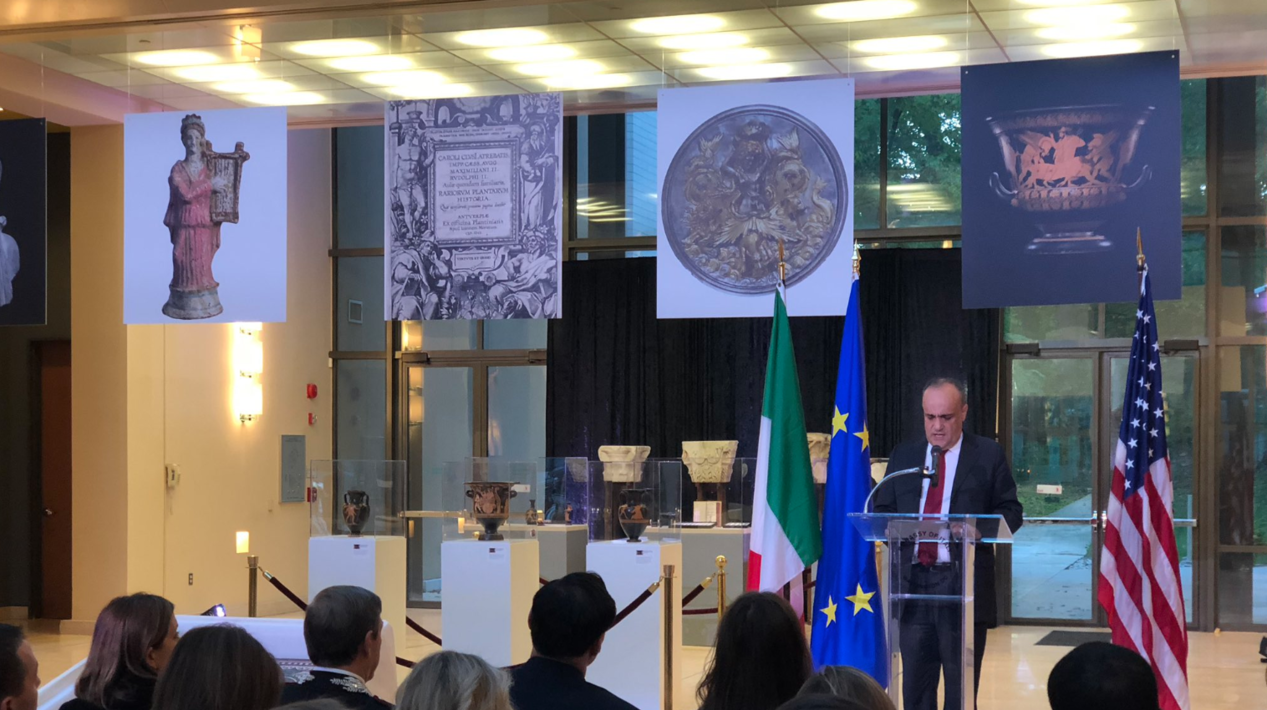Stolen Works of Art Recovered in the United States and Returned to Italy
The evening was also a celebration of a seventeen-year long collaboration between the Italy and the United States to protect Italian art, antiquities, and cultural objects as a means to preserve our common heritage for future generations.
Leaders from Italy and the United States signed a Memorandum of Understanding in 2001, providing for joint law enforcement efforts, as well as exhibition and academic programs to combat the illicit removal of cultural objects. Since this landmark cultural agreement was signed, both countries have recovered more than 200 artifacts, some of which were on display at the Embassy. The works were illicitly imported into the United States as a result of theft and illegal excavation of archeological sites in Italy.
Some of the artifacts recovered over the last seventeen years include books from the sixteenth and seventeenth centuries, frescoes from Pompeii, and fragments of Roman marble mosaic.
“Global collaboration is essential – without public access to these artworks our children lose the ability to see firsthand how the world has evolved,” remarked Robert Johnson, Assistant Director of the Criminal Investigative Division, before unveiling the newly recovered artifacts to the Minister.
The newly published catalog “Saving Art Preserving Heritage,” conceived by the Embassy of Italy and available at the repatriation ceremony, brings together the hundreds of art and antiques the United States has returned to Italy since the Memorandum of Understanding was signed. Dr. Catherine P. Foster of the Cultural Heritage Center at the U.S. State Department and Renato Miracco, Curator, Critic, and Cultural Attaché of the Embassy of Italy, edited the catalog.
In his opening remarks, the Ambassador of Italy to the United States, Armando Varricchio, regarded the catalog as a measure of the value of the work “to heal an open wound and reconstruct a historic memory that risked being lost forever, or remaining the prerogative of the few, rather than being universally available to all.” The catalog is a reminder of what is lost through illegal looting and trafficking of artwork.
“This catalog is a testimony of what can be accomplished when we work together,” added Alysa D. Erichs, the Deputy Executive Associate Director for Homeland Security Investigations. The federal agency works with specially trained border officers on how to identify and handle cultural property.
Robert Johnson also touched on the Art Crime Team of the FBI, composed of 22 special agents who have received specialized training in art and cultural property investigations. The Team works with other law enforcement agencies across the globe to reduce the incentive for crimes such as the theft and selling of illegally acquired art.
“This anti-trafficking training builds respect and mutual understanding between our two great nations,” believes Marie Royce, Assistant Secretary of the Bureau of Educational and Cultural Affairs in the United States. Cultural cooperation has been the source of a thriving friendship between the United States and Italy, as museums, universities, artists, researchers, and archeologists contribute to an enriching exchange across the Atlantic.
“A cultural object cannot be enjoyed if it has a criminal origin. A sensitivity to the cultural objects makes the fight to protect them more effective, and this sensitivity is stronger today more than ever,” Brigadier General Fabrizio Parrulli explained to the large audience gathered in the open expanse at the center of the Embassy.
The exhibit behind the speakers, ancient vases and statuettes encased in glass under dazzling blue lights, was acclaimed and enjoyed by everyone there.
“Heritage is a fundamental part of our relationship. Walking down the streets of Washington, DC, it is clear the architecture of the buildings was derived and inspired by Italian architecture,” the Minister reflected before the reveal of three small artifacts, symbolizing the return of stolen pieces of culture.
A Campanian lekanis vase, an Attic white-ground vase, and an Eastern Mediterranean core-formed glass oinochoe were under the black cover, unveiled by Robert Johnson to the Minister with great applause from the crowd.
Afterwards, people gathered around the exhibit for wine and antipasti while admiring the magnificent and ancient works, finally and rightfully returned to the Italian public.












































i-Italy
Facebook
Google+
This work may not be reproduced, in whole or in part, without prior written permission.
Questo lavoro non può essere riprodotto, in tutto o in parte, senza permesso scritto.